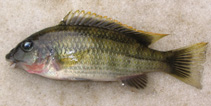| Diagnosis: |
Dorsal spines (total): 16-18; Dorsal soft rays (total): 8-12; Anal spines: 3-3; Anal soft rays: 5-9. Diagnosis: snout protuberant; mouth inferior, bearing numerous rows of extremely fine, comb-like, spatulate teeth on both oral jaws; upper lip broad and thick, with a distinctive lip crease (Ref. 81260).
Description: body more or less ovoid (Ref. 52307), moderately deep, more so in Gabonese than Congolese specimens (Ref. 81260). Snout protuberant (Ref. 81260) and rounded, with arched upper profile (Ref. 2989, 52342). Mouth inferior (Ref. 81260), extending to below nostril (Ref. 2989, 52342). Jaws small and robust bearing numerous rows of extremely fine, depressible, spatulate teeth; tooth rows more numerous in both jaws in Congolese specimens (8-9 rows in upper jaw) than in Gabonese specimens (5-6 rows in upper jaw); thick upper lip bearing a distinctive deep crease on lateral face; caudal peduncle short and deep (Ref. 81260). 3-4 scale rows on cheek (Ref. 2989, 52342, 53262). 4-5 scales between upper lateral line and dorsal fin origin; epibranchial rakers reduced in size and number, often entirely lacking (Ref. 81260). Dorsal fin spines increasing in length to the last; pectoral fin not extending to vertical from origin of anal fin (Ref. 2989, 52342, 53262). Tips of pelvic fins (first ray) rarely reach anal fin origin, even in mature individuals (Ref. 2989, 52342, 81260). No obvious "tilapia spot" in soft dorsal fin; gut of this herbivorous species extremely long (over 14 times SL) and complexly coiled, filling entire abdominal cavity (Ref. 81260).
Coloration: no live coloration data available for Congolese specimens, but specimens from the Chiloango system (Lukula and Luali Rivers) are uniform olive-brown above, yellowish beneath and with greyish or brown fins (Ref. 81260). 2 longitudinal stripes may be visible, depending on the situation: the lower one runs along the mid-body and the upper one runs immediately under the dorsal fin; anterior and snout dark grey; breast and belly of larger specimens appear rosy to reddish; dark spot at beginning of soft dorsal often visible; unpaired fins yellowish to bluish; juveniles with dark vertical bars (Ref. 52307). Preserved specimens: brown base body coloration, somewhat paler ventrally; faint traces of a series of vertical bars sometimes present, but dominant marking is a mid-lateral band, which is variously developed but usually present; Gabonese specimens usually with more strongly marked vertical barring and only traces of somewhat disjunct longitudinal banding; dominance of vertical barring over longitudinal banding particularly marked in preserved Gabonese
specimens (Ref. 81260). |
